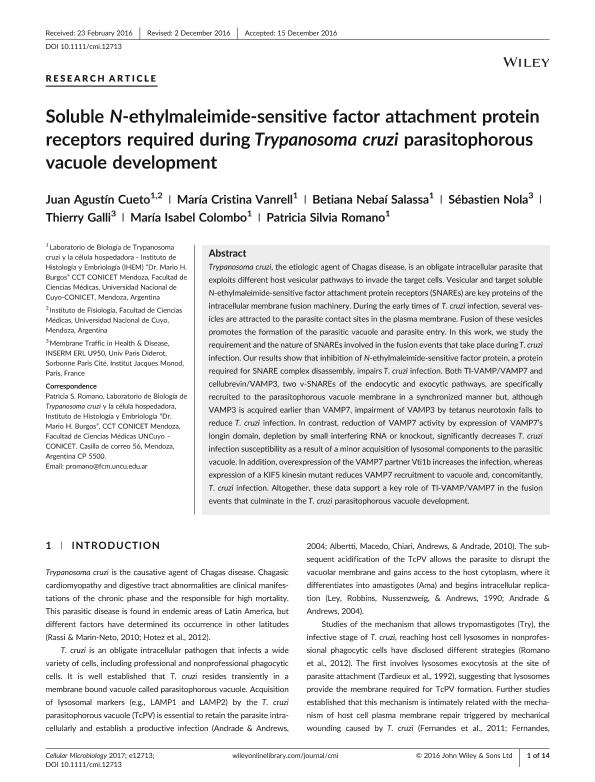Artículo
Soluble N-ethylmaleimide-sensitive factor attachment protein receptors required during Trypanosoma cruzi parasitophorous vacuole development
Cueto, Juan Agustin ; Vanrell, Maria Cristina
; Vanrell, Maria Cristina ; Salassa, Betiana Nebaí
; Salassa, Betiana Nebaí ; Nola, Sebastien; Galli, Thierry; Colombo, Maria Isabel
; Nola, Sebastien; Galli, Thierry; Colombo, Maria Isabel ; Romano, Patricia Silvia
; Romano, Patricia Silvia
 ; Vanrell, Maria Cristina
; Vanrell, Maria Cristina ; Salassa, Betiana Nebaí
; Salassa, Betiana Nebaí ; Nola, Sebastien; Galli, Thierry; Colombo, Maria Isabel
; Nola, Sebastien; Galli, Thierry; Colombo, Maria Isabel ; Romano, Patricia Silvia
; Romano, Patricia Silvia
Fecha de publicación:
06/2017
Editorial:
Wiley Blackwell Publishing, Inc
Revista:
Cellular Microbiology (print)
ISSN:
1462-5814
Idioma:
Inglés
Tipo de recurso:
Artículo publicado
Clasificación temática:
Resumen
Trypanosoma cruzi, the etiologic agent of Chagas disease, is an obligate intracellular parasite that exploits different host vesicular pathways to invade the target cells. Vesicular and target soluble N-ethylmaleimide-sensitive factor attachment protein receptors (SNAREs) are key proteins of the intracellular membrane fusion machinery. During the early times of T. cruzi infection, several vesicles are attracted to the parasite contact sites in the plasma membrane. Fusion of these vesicles promotes the formation of the parasitic vacuole and parasite entry. In this work, we study the requirement and the nature of SNAREs involved in the fusion events that take place during T. cruzi infection. Our results show that inhibition of N-ethylmaleimide-sensitive factor protein, a protein required for SNARE complex disassembly, impairs T. cruzi infection. Both TI-VAMP/VAMP7 and cellubrevin/VAMP3, two v-SNAREs of the endocytic and exocytic pathways, are specifically recruited to the parasitophorous vacuole membrane in a synchronized manner but, although VAMP3 is acquired earlier than VAMP7, impairment of VAMP3 by tetanus neurotoxin fails to reduce T. cruzi infection. In contrast, reduction of VAMP7 activity by expression of VAMP7's longin domain, depletion by small interfering RNA or knockout, significantly decreases T. cruzi infection susceptibility as a result of a minor acquisition of lysosomal components to the parasitic vacuole. In addition, overexpression of the VAMP7 partner Vti1b increases the infection, whereas expression of a KIF5 kinesin mutant reduces VAMP7 recruitment to vacuole and, concomitantly, T. cruzi infection. Altogether, these data support a key role of TI-VAMP/VAMP7 in the fusion events that culminate in the T. cruzi parasitophorous vacuole development.
Palabras clave:
Ti-Vamp/Vamp7
,
Chagas Disease
,
Cellubrevin/Vamp3
,
Host Cell
,
Snares
Archivos asociados
Licencia
Identificadores
Colecciones
Articulos(IHEM)
Articulos de INST. HISTOLOGIA Y EMBRIOLOGIA DE MEND DR.M.BURGOS
Articulos de INST. HISTOLOGIA Y EMBRIOLOGIA DE MEND DR.M.BURGOS
Citación
Cueto, Juan Agustin; Vanrell, Maria Cristina; Salassa, Betiana Nebaí; Nola, Sebastien; Galli, Thierry; et al.; Soluble N-ethylmaleimide-sensitive factor attachment protein receptors required during Trypanosoma cruzi parasitophorous vacuole development; Wiley Blackwell Publishing, Inc; Cellular Microbiology (print); 19; 6; 6-2017; 1-14
Compartir
Altmétricas



